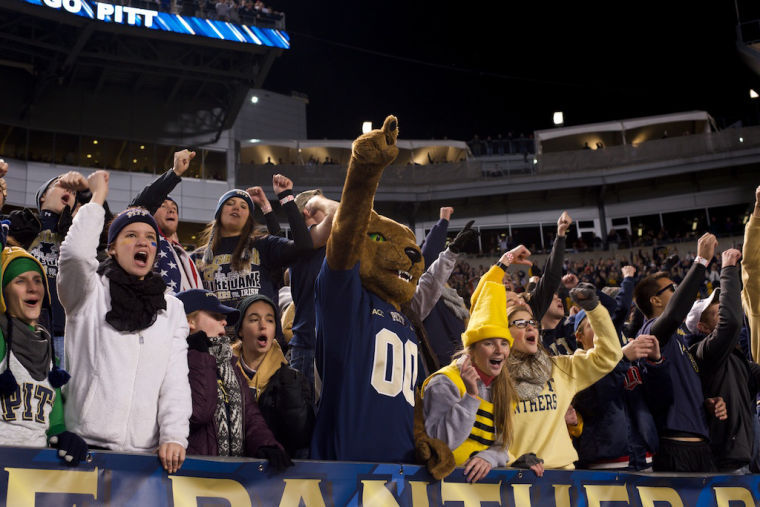‘Roc’ a tradition of school pride upheld by students behind suit
January 6, 2014
As the shot goes up and the fans anticipate the result of the game, another, more recognizable fan is also waiting for the shot to go in or bounce off the rim. As the ball exits the bottom of the net, Roc, Pitt’s mascot, leaps from the sideline, throws his paws in the air and becomes the ringleader for the ensuing mayhem.
The person currently behind the suit is current senior John Kornaga, who has worn the suit since his sophomore year. Kornaga hails from the Greater Philadelphia area majoring in finance in the College of Business Administration.
Because Kornaga was always a bit of a class clown in high school, his transformation isn’t at all surprising for him. But becoming the mascot for a Division I university was the result of something very common to men: a dare.
“I told my roommate about [the opening for the mascot position] and he said to me, ‘You won’t go try out. I dare you to do it. You won’t,’” Kornaga said. “And from there I went, showed off some dance moves, did a routine to some music and eventually got the position as Roc.”
Although Kornaga’s tenure as Roc has been relatively short, the development of Roc — and the Panther — has spanned multiple centuries.
Until 1909, Pitt was known as Western University of Pennsylvania and was located on the North Side.
The school’s team name was the Wups, derived from the University’s nickname “Wup.” Once the location of the school moved from the North Side to Oakland, the name University of Pittsburgh was adopted and the Panthers were born.
George M.P. Baird, who wrote the University’s alma mater and suggested the name the “Panthers,” says it was chosen for a multitude of reasons.
Acccording to the University’s web site, Baird said the most important reasons are that panthers once populated the Pittsburgh area, the alliteration with the word Pittsburgh and that no other college had that mascot at the time. The University was evolving into a very different, new and exciting entity.
It wasn’t until the 1990s that Pitt’s mascot became what he’s known as today: Roc.
The name serves to commemorate former Pitt football player, assistant coach, assistant to the athletic director and lifelong fan, Steve “the Rock” Petro.
“Steve was a man who loved his school with unwavering loyalty, regardless of the fortunes,” former football head coach John Majors said. “Never in my life have I met a man that I thought was more loyal and more dedicated and had a deeper love for one school than Steve Petro had for the Panthers and the University of Pittsburgh.”
And now as the physical embodiment of that dedication, Kornaga as Roc must continue the tradition of Pitt pride set before him.
After earning the mascot position, Kornaga had to shadow the previous mascot for a three-month period. During that time, learning to mimic the movements and mannerisms became vital to the process.
With that in mind, learning to make the position unique is equally as important. But there are certain things that won’t change from mascot to mascot.
For instance, at Pitt football games, the mascot must do push-ups after each touchdown for every point the team has scored by that point. After one touchdown, Roc does seven push-ups, after two, he does 14 and continues this pattern for as many touchdowns as Pitt scores in one game.
It might be hard to notice Roc during a football game because of the size of the stadium, but this isn’t true for the basketball games held at the Petersen Events Center.
“I love football games, but the basketball games are awesome,” Kornaga said. “You’re just as much a part of the game as the players. You can swing the entire mood of the crowd with your own enthusiasm. Leading the Zoo in chants will always be a fond memory of mine.”
Fortunately for Roc, the student body reciprocates his feelings of gratitude.
“It’s always fun to see the team win, but with Pitt you never know,” lifelong Pitt fan and junior Cooper Cullen said. “Seeing Roc run out of the tunnel with the team and the flag in his hands is the best. He means so much to the University and to us as students.”
The time commitment of a college mascot is sizeable. During the winter season, Roc can appear in five games a week, on average. That includes both men’s and women’s basketball and football.
When the University has games that garner national media attention, Roc must travel with the respective team. So while there are “down” weeks in which time isn’t a concern, being Roc the Panther can take up about 15-35 hours in a week.
Even still, all of the work, the weight lost (the Roc suit becomes extremely hot, for which Kornaga developed a fitness plan to prepare) and time spent is worth it.
“My mom always puts it best, saying Roc is ‘the face of the University,’” Kornaga said. “From being a presence at sporting events to showing up at community events, everyone is always excited to see Roc, and I feel like it is a lot of responsibility to make sure I don’t do anything to disappoint those who look forward to seeing Roc.”



